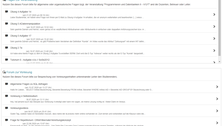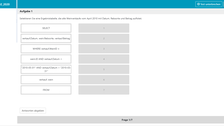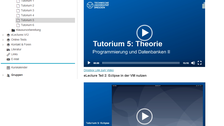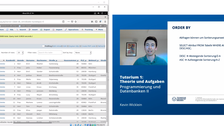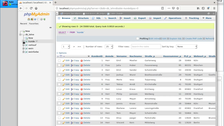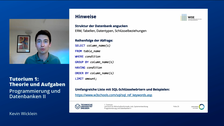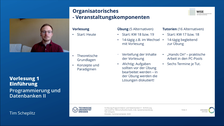Programming and Databases 2: Tim Scheplitz, Marcel Susky, Kai Gand, Linda Kosmol (#TS1)
Format
Compulsory course as part of the fundamental studies for all economics students; n = approx. 500
Broad range of previous knowledge due to different degree programs and school-age education standards
Course composed of a virtual lecture, practical and tutorial
- Lecture (asynchronous):
- E-lecture; approx. 6 clips per lecture; OBS recording; integrated into OPAL via MAGMA and available as a Nextcloud link
- PDF of each lecture’s slides
- OPAL forums / email
- Links to additional materials and references
- Practical (asynchronous):
- Students sorted into 5 OPAL groups
- E-lecture; approx. 3 clips per practical; OBS recording; integrated into OPAL via MAGMA & available as a Nextcloud link
- PDF of slides (exercises and later solutions)
- Accompanying ONYX test
- OPAL forums / email
- Tutorial (synchronous/asynchronous):
- Students sorted into 16 OPAL groups of approx. 20
- Slide set incl. exercises for each tutorial
- Virtual workspace (virtual machine with development environment) for completing the exercises
- Back-up: independent use of the computer pool
- At least 3 e-lecture clips per tutorial (theory review, discussion of exercises, sample solutions)
- Matrix room for each tutorial group as a form of synchronous office hours and for group discussion
- Accompanying ONYX tests to each tutorial
- OPAL forums / email
Keywords
Fundamental studies, large-scale course, combination of learning formats, Business Information Systems, database systems
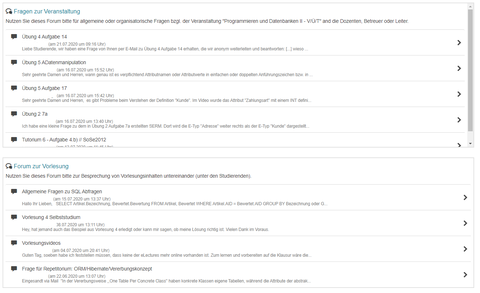
© Tim Scheplitz
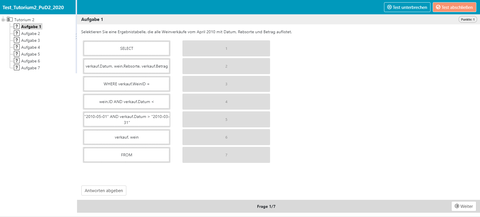
© Tim Scheplitz
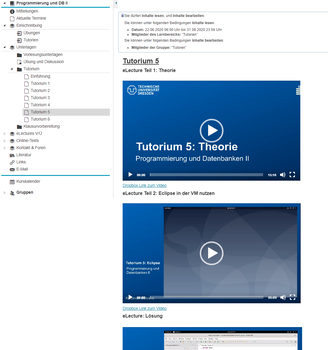
© Tim Scheplitz
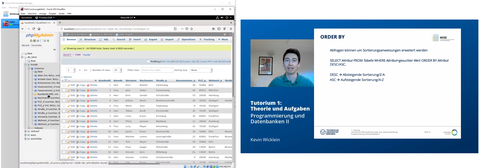
© Tim Scheplitz
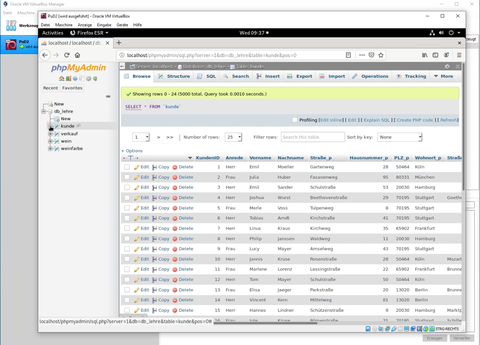
© Tim Scheplitz
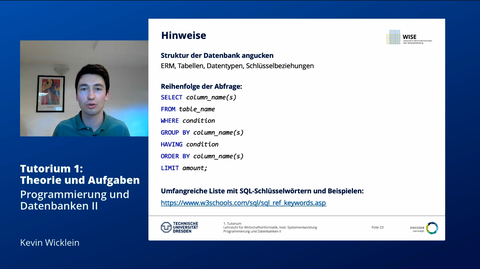
© Tim Scheplitz
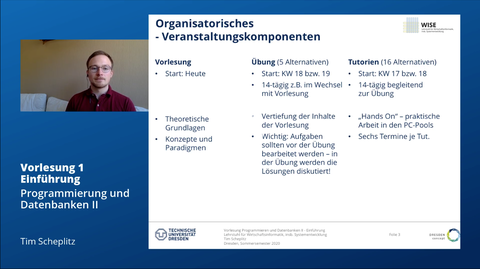
© Tim Scheplitz
Description
Our course belongs to the fundamental studies of all students enrolled in the Faculty of Business and Economics. In this compulsory course, students grappled with the design and use of database systems and the necessary concepts and paradigms that accompany them. This helps them improve their understanding of and gain skills working with socio-technical information systems in a workplace context. The course is composed of a lecture, practical and tutorial. All of these took place virtually during the 2020 summer semester, affording participants easy access.
Each lecture was divided into thematic segments, for which short videos of about 10–15 minutes were recorded. The short e-lectures were uploaded to OPAL via Magma integration and Nextcloud links were provided as a fallback. Due to their brevity, the videos were particularly successful in maintaining students’ attention. The practicals were presented in a similar format. We discussed theory and application-based exercises in e-lecture clips and presented these for discussion on the OPAL forum. Students could always send questions to the team of lecturers directly via email or discuss them in OPAL forums with their peers and teaching staff as well as with tutors in Matrix groups.
The tutorials presented their own set of challenges. They had always contributed significantly to relaying skills in the past, but we could not hold them in the computer pool rooms as usual during the pandemic. The underlying goal of the tutorials is to consolidate theoretical knowledge and to familiarize students with how it looks in practice. To consolidate theoretical knowledge, we recorded a clip for each tutorial, in which we reviewed the relevant content and introduced the tasks for each tutorial. In the subsequent week, the students were invited to work on these tasks independently or to ask questions in one of the many live tutorials, which were held online in Matrix groups. At the end of each week, a video was compiled which explained the solution in detail. Since many students did not have experience with programming or databases prior to this course, it was critical that this introduction be straightforward. Students therefore received access to a virtual machine that corresponded to a software environment fully suited to their needs. Software, libraries, datasets and settings were pre-configured and students could easily access them on their own devices to complete the tutorial exercises. Students had the option of taking a voluntary online test on ONYX to check their own progress. Overall, we were able use these moderated and independent teaching methods to offer students this fundamental course despite the challenging circumstances.
Lessons learned:
- Asynchronous e-lectures should remain a permanent offering at TUD, even if this means it is harder to structure the continued learning process (e.g. because a time limit to the e-lecture clips would not be possible).
- Short clips which feature the lecturer can offset the anonymity of remote learning.
- Synchronous features such as chat rooms and office hours require carefully planned incentives for the students.
- A broad spectrum of teaching formats is well suited to meet the wide range of needs represented in large courses in the early stages of a degree program.
Contact
Tim Scheplitz
Marcel Susky
Kai Gand
Linda Kosmol
Voting ID
#TS1
